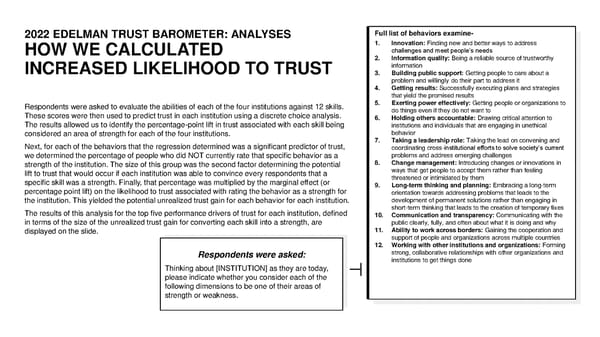2022 EDELMAN TRUST BAROMETER: ANALYSES Full list of behaviors examine- 1. Innovation: Finding new and better ways to address HOW WE CALCULATED challenges and meet people’s needs 2. Information quality: Being a reliable source of trustworthy INCREASED LIKELIHOOD TO TRUST information 3. Building public support: Getting people to care about a problem and willingly do their part to address it 4. Getting results: Successfully executing plans and strategies that yield the promised results Respondents were asked to evaluate the abilities of each of the four institutions against 12 skills. 5. Exerting power effectively: Getting people or organizations to These scores were then used to predict trust in each institution using a discrete choice analysis. do things even if they do not want to The results allowed us to identify the percentage-point lift in trust associated with each skill being 6. Holding others accountable: Drawing critical attention to institutions and individuals that are engaging in unethical considered an area of strength for each of the four institutions. behavior Next, for each of the behaviors that the regression determined was a significant predictor of trust, 7. Taking a leadership role: Taking the lead on convening and coordinating cross-institutional efforts to solve society’s current we determined the percentage of people who did NOT currently rate that specific behavior as a problems and address emerging challenges strength of the institution. The size of this group was the second factor determining the potential 8. Change management:Introducing changes or innovations in lift to trust that would occur if each institution was able to convince every respondents that a ways that get people to accept them rather than feeling specific skill was a strength. Finally, that percentage was multiplied by the marginal effect (or threatened or intimidated by them percentage point lift) on the likelihood to trust associated with rating the behavior as a strength for 9. Long-term thinking and planning: Embracing a long-term orientation towards addressing problems that leads to the the institution. This yielded the potential unrealized trust gain for each behavior for each institution. development of permanent solutions rather than engaging in The results of this analysis for the top five performance drivers of trust for each institution, defined short-term thinking that leads to the creation of temporary fixes in terms of the size of the unrealized trust gain for converting each skill into a strength, are 10. Communication and transparency: Communicating with the public clearly, fully, and often about what it is doing and why displayed on the slide. 11. Ability to work across borders: Gaining the cooperation and support of people and organizations across multiple countries 12. Working with other institutions and organizations: Forming Respondents were asked: strong, collaborative relationships with other organizations and institutions to get things done Thinking about [INSTITUTION] as they are today, please indicate whether you consider each of the following dimensions to be one of their areas of strength or weakness.
 2022 Trust Barometer Page 61 Page 63
2022 Trust Barometer Page 61 Page 63